 W
WA banana connector is a single-wire electrical connector used for joining wires to equipment. The term 4 mm connector is also used, especially in Europe, although not all banana connectors will mate with 4 mm parts, and 2 mm banana connectors exist. Various styles of banana plug contacts exist, all based on the concept of spring metal applying outward force into the unsprung cylindrical jack to produce a snug fit with good electrical conductivity. Common types include: a solid pin split lengthwise and splayed slightly, a tip of four leaf springs, a cylinder with a single leaf spring on one side, a bundle of stiff wire, a central pin surrounded by a multiple-slit cylinder with a central bulge, or simple sheet spring metal rolled into a nearly complete cylinder. The plugs are frequently used to terminate patch cords for electronic test equipment, while sheathed banana plugs are common on multimeter probe leads.
 W
WA pin header is a form of electrical connector. It consists of one or more rows of male pins typically spaced 2.54 millimetres (0.1 in) apart, but common sizes also include 5.08 millimetres (0.2 in), 5.00 millimetres (0.197 in), 3.96 millimetres (0.156 in), 2.00 millimetres (0.079 in), 1.27 millimetres (0.05 in) and 1.00 millimetre (0.04 in). The distance between pins is known as pitch.
 W
WA bus-holder is a weak latch circuit which holds last value on a tri-state bus.
 W
WA concentric twinax connector has a center pin and a cylindrical intermediate contact as compared to a dual polarized pin type.
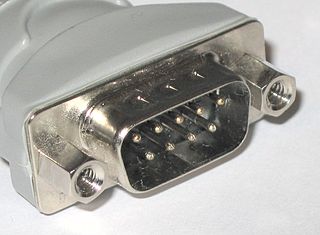 W
WThe D-subminiature or D-sub is a common type of electrical connector. They are named for their characteristic D-shaped metal shield. When they were introduced, D-subs were among the smallest connectors used on computer systems.
 W
WThe D-subminiature or D-sub is a common type of electrical connector. They are named for their characteristic D-shaped metal shield. When they were introduced, D-subs were among the smallest connectors used on computer systems.
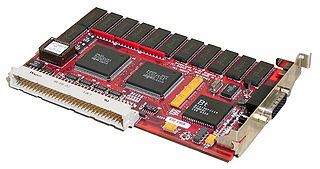 W
WDIN 41612 is a DIN standard for electrical connectors that are widely used in rack based electrical systems. Standardisation of the connectors is a pre-requisite for open systems, where users expect components from different suppliers to operate together. The most widely known use of DIN 41612 connectors is in the VMEbus system. They were also used by NuBus. The standard has subsequently been upgraded to international standards IEC 60603-2 and EN 60603-2.
 W
WElastomeric connectors, also known by the registered trademark ZEBRA connectors, consist of alternating conductive and insulating regions in a rubber or elastomer matrix to produce overall anisotropic conductive properties. The original version consisted of alternating conductive and insulating layers of silicone rubber, cut crosswise to expose the thin layers. They provide high-density redundant electrical paths for high reliability connections. One of the first applications was connecting thin and fragile glass liquid crystal displays (LCDs) to circuit boards in electronic devices, as little current was required.
 W
WEuroblock, short for "European-style terminal block", is a low-voltage disconnectable connector and terminal block combination commonly used for microphone- and line level-audio signals, and for control signals such as RS-232 or RS-485. It is also known as the Phoenix connector from one of the manufacturers, Phoenix Contact, a German company whose US operations were established in 1981 in Harrisburg, Pennsylvania; though there are many manufacturers who make compatible products. It is also known as "Combicon", which might be a Phoenix brand name; or more generically as a "pluggable terminal block" or a "two piece terminal block".
 W
WA Fahnestock clip is an early type of spring clamp electrical terminal for connections to bare wires. It is still used in educational electronic kits and teaching laboratories in schools. It is designed to grip a bare wire securely, yet release it with the push of a tab. The clip was patented February 26, 1907 by John Schade Jr., assigned to Fahnestock Electric Co. Less than 2 weeks after the patent was issued they filed for reissue.
 W
WA pin header is a form of electrical connector. It consists of one or more rows of male pins typically spaced 2.54 millimetres (0.1 in) apart, but common sizes also include 5.08 millimetres (0.2 in), 5.00 millimetres (0.197 in), 3.96 millimetres (0.156 in), 2.00 millimetres (0.079 in), 1.27 millimetres (0.05 in) and 1.00 millimetre (0.04 in). The distance between pins is known as pitch.
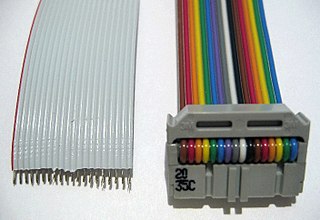 W
WAn insulation-displacement contact (IDC), also known as insulation-piercing contact (IPC), is an electrical connector designed to be connected to the conductor(s) of an insulated cable by a connection process which forces a selectively sharpened blade or blades through the insulation, bypassing the need to strip the conductors of insulation before connecting. When properly made, the connector blade cold-welds to the conductor, making a theoretically reliable gas-tight connection.
 W
WA gender changer or "gender-bender", is a hardware device placed between two cable connectors of the same type and gender. An example is a cable connector shell with either two female or two male connectors on it, used to correct the mismatches that result when interconnecting two devices or cables with the same gender of connector.
 W
WIn sound recording and reproduction, ground lift or earth lift is a technique used to reduce or eliminate ground-related noise arising from ground loops in audio cables. It may also increase or decrease noise from other sources. Activating the ground lift on a particular piece of equipment opens the connection between the equipment ground and the shielding conductor of audio cables attached to the equipment, leaving those cables grounded only at their opposite end.
 W
WA pin header is a form of electrical connector. It consists of one or more rows of male pins typically spaced 2.54 millimetres (0.1 in) apart, but common sizes also include 5.08 millimetres (0.2 in), 5.00 millimetres (0.197 in), 3.96 millimetres (0.156 in), 2.00 millimetres (0.079 in), 1.27 millimetres (0.05 in) and 1.00 millimetre (0.04 in). The distance between pins is known as pitch.
 W
WAn insulation-displacement contact (IDC), also known as insulation-piercing contact (IPC), is an electrical connector designed to be connected to the conductor(s) of an insulated cable by a connection process which forces a selectively sharpened blade or blades through the insulation, bypassing the need to strip the conductors of insulation before connecting. When properly made, the connector blade cold-welds to the conductor, making a theoretically reliable gas-tight connection.
 W
WAn insulation-displacement contact (IDC), also known as insulation-piercing contact (IPC), is an electrical connector designed to be connected to the conductor(s) of an insulated cable by a connection process which forces a selectively sharpened blade or blades through the insulation, bypassing the need to strip the conductors of insulation before connecting. When properly made, the connector blade cold-welds to the conductor, making a theoretically reliable gas-tight connection.
 W
WJST connectors are electrical connectors manufactured to the design standards originally developed by J.S.T. Mfg. Co.. JST manufactures numerous series (families) and pitches of connectors.
 W
WA keystone module is a standardized snap-in package for mounting a variety of low-voltage electrical jacks or optical connectors into a keystone wall plate, face plate, surface-mount box, or a patch panel.
 W
WA pin header is a form of electrical connector. It consists of one or more rows of male pins typically spaced 2.54 millimetres (0.1 in) apart, but common sizes also include 5.08 millimetres (0.2 in), 5.00 millimetres (0.197 in), 3.96 millimetres (0.156 in), 2.00 millimetres (0.079 in), 1.27 millimetres (0.05 in) and 1.00 millimetre (0.04 in). The distance between pins is known as pitch.
 W
WA pin header is a form of electrical connector. It consists of one or more rows of male pins typically spaced 2.54 millimetres (0.1 in) apart, but common sizes also include 5.08 millimetres (0.2 in), 5.00 millimetres (0.197 in), 3.96 millimetres (0.156 in), 2.00 millimetres (0.079 in), 1.27 millimetres (0.05 in) and 1.00 millimetre (0.04 in). The distance between pins is known as pitch.
 W
WA pin header is a form of electrical connector. It consists of one or more rows of male pins typically spaced 2.54 millimetres (0.1 in) apart, but common sizes also include 5.08 millimetres (0.2 in), 5.00 millimetres (0.197 in), 3.96 millimetres (0.156 in), 2.00 millimetres (0.079 in), 1.27 millimetres (0.05 in) and 1.00 millimetre (0.04 in). The distance between pins is known as pitch.
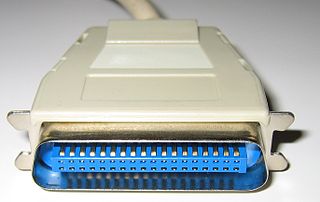 W
WThe micro ribbon or miniature ribbon connector is a common type of electrical connector for a variety of applications, such as in computer and telecommunications equipment having many contacts.
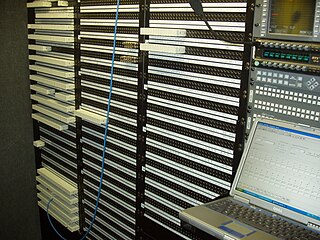 W
WA patch panel, patch bay, patch field or jack field is a device or unit featuring a number of jacks, usually of the same or similar type, for the use of connecting and routing circuits for monitoring, interconnecting, and testing circuits in a convenient, flexible manner. Patch panels are commonly used in computer networking, recording studios, radio and television.
 W
WA pin header is a form of electrical connector. It consists of one or more rows of male pins typically spaced 2.54 millimetres (0.1 in) apart, but common sizes also include 5.08 millimetres (0.2 in), 5.00 millimetres (0.197 in), 3.96 millimetres (0.156 in), 2.00 millimetres (0.079 in), 1.27 millimetres (0.05 in) and 1.00 millimetre (0.04 in). The distance between pins is known as pitch.
 W
WA shielded data link connector is a type of electrical connector in which the signal pins are surrounded by a metal shield. The connector was designed by AMP and is available with a range of pins. It also features a locking mechanism and is available in differently keyed plugs that correspond to the proper socket.
 W
WA pin header is a form of electrical connector. It consists of one or more rows of male pins typically spaced 2.54 millimetres (0.1 in) apart, but common sizes also include 5.08 millimetres (0.2 in), 5.00 millimetres (0.197 in), 3.96 millimetres (0.156 in), 2.00 millimetres (0.079 in), 1.27 millimetres (0.05 in) and 1.00 millimetre (0.04 in). The distance between pins is known as pitch.
 W
WThe U-229 is a cable connector currently used by the U.S. military for audio connections to field radios, typically for connecting a handset. There are five-pin and six-pin versions. This type of connector is also used by the National Security Agency to load cryptographic keys into encryption equipment from a fill device.
 W
WUniversal EXTension (UEXT) is a connector layout which includes power and three serial buses: Asynchronous, I2C, and SPI. The connector layout was specified by Olimex Ltd and declared an open-project that is royalty-free.
 W
WA very-high-density cable interconnect (VHDCI) is a 68-pin connector that was introduced in the SPI-2 document of SCSI-3. The VHDCI connector is a very small connector that allows placement of four wide SCSI connectors on the back of a single PCI card slot. Physically, it looks like a miniature Centronics type connector. It uses the regular 68-contact pin assignment. The male connector (plug) is used on the cable and the female connector ("receptacle") on the device.
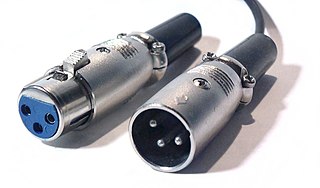 W
WThe XLR connector is a type of electrical connector primarily found on professional audio, video, and stage lighting equipment. The connectors are circular in design and have between three and seven pins. They are most commonly associated with balanced audio interconnection, including AES3 digital audio, but are also used for lighting control, low-voltage power supplies, and other applications. XLR connectors are available from a number of manufacturers and are covered by an international standard for dimensions, IEC 61076-2-103. They are superficially similar to the smaller DIN connector range, but are not physically compatible with them.